Musicista is a tool that combines music with computer science and offers the ability to run algorithms on musical notation. It has its own file format .musicista to store all information, but it can also read MusicXML- and Midi-files.
This software is licensed under GPL v3.0.
Install Windows-App View on Github Like on Facebook

Musicista files have six sections:
<Piece>
<Meta />
<Instruments />
<Score />
<Parts />
<Comments />
<Style />
</Piece>
The meta data section stores title, composer, etc.:
<Meta>
<Title>Gute Nacht</Title>
<Subtitle>Ein Cyclus von Liedern von Wilhelm Müller. Für eine Singstimme mit Begleitung des Pianoforte</Subtitle>
<People>
<Composer FirstName="Franz" LastName="Schubert" Born="1797-01-31" Died="1828-11-19" />
<Lyricist FirstName="Wilhelm" LastName="Müller" Born="1794-10-07" Died="1827-10-01" />
</People>
<Collection>Die Winterreise</Collection>
<Opus Number="89" SubNumber="0" />
<Epoch>Romantik</Epoch>
<Form>Lied</Form>
<Dates>
<Composition Date="1827-02" />
<Publication Date="1828-01-24" Publisher="Tobias Haslinger" />
<Performance Date="1828-01-10" IsFirst="true" Place="Musikverein, Wien">Ludwig Tietze</Performance>
<Engraving Date="2014-09-10" Typesetter="Jannik Arndt" />
</Dates>
<Dedication />
<AverageDuration>5:38</AverageDuration>
<BeatsPerMinute>90</BeatsPerMinute>
<MusicalKey Step="D" Gender="Minor" />
<Copyright>Public Domain</Copyright>
<Weblink>http://musicistaapp.de/?ddownload=62</Weblink>
<Notes>Deutsch-Verzeichnis D911</Notes>
<Software>Musicista 1.0</Software>
</Meta>
The instruments section defines instrument groups, instruments and staves:
<Instruments>
<InstrumentGroup Name="Woodwind" BraceType="Bracket">
<Instrument ID="1" Name="Flute 1" Shortname="Fl. 1">
<Staff ID="1"/>
</Instrument>
<Instruments ID="2" Name="Flute 2" Shortname="Fl. 2">
<Staff ID="2" PrintInStaff="1"/>
</Instrument>
</InstrumentGroup>
<InstrumentGroup Name="Brass" BraceType="None">
<Instrument ID="3" Name="Trumpet in Bb" Transposition="-2">
<Staff ID="3"/>
</Instrument>
</InstrumentGroup>
<InstrumentGroup Name="Keys" BraceType="Brace">
<Instrument ID="4" Name="Piano" Shortname="Pno.">
<Staff ID="4"/>
<Staff ID="5"/>
</Instrument>
</InstrumentGroup>
<InstrumentGroup Name="Strings" BraceType="Bracket">
<Instrument ID="5" Name="Violoncello" Shortname="Vc.">
<Staff ID="6"/>
</Instrument>
<Instrument ID="6" Name="Double Bass" Shortname="Db.">
<Staff ID="7"/>
</Instrument>
</InstrumentGroup>
</Instruments>
The actual music is stored in the Score section, hierarchically structured:
<Score>
<Section>
<Movement Number="0" BeatsPerMinute="0">
<Segment>
<Passage>
<MeasureGroup MeasureNumber="1">...</MeasureGroup>
</Passage>
</Segment>
</Movement>
</Section>
</Score>
MeasureGroup tags group measures from different instruments that occur at the same time in the score. This resembles the timewise dialect of MusicXML.
<MeasureGroup MeasureNumber="6" RehearsalMark="A">
<TimeSignature Beats="4" BeatUnit="4"/>
<KeySignature Step="F" Gender="Major"/>
<Tempo Beat="1" Text="Allegro" />
<Repetition Beat="4" Sign="SegnoSign" />
<Barline Location="Right" Type="EndRepeat"/>
<Measure Clef="Treble" InstrumentID="1" StaffID="1">
<Note Voice="1" Duration="Quarter" Beat="1" Step="C" Octave="5"/>
<Note Voice="1" Duration="Quarter" Beat="2" Step="D" Octave="5"/>
<Note Voice="1" Duration="Quarter" Beat="3" Step="E" Octave="5"/>
<Note Voice="1" Duration="Quarter" Beat="4" Step="F" Octave="5"/>
</Measure>
<Measure Clef="Bass" InstrumentID="2" StaffID="2">
<Note Voice="1" Duration="Whole" Beat="1" Step="C" Octave="3"/>
</Measure>
</MeasureGroup>
Notes consist of Step, Octave, Duration and Beat but can have several additional attributes. Possible child tags are Articulation, Lyrics and analysis tags such as Harmony or NoteAttribute:
<Note Step="C" Octave="4" Duration="Eighth" Beat="1" Voice="1">
<Articulation Bowing="Pizzicato" Accent="Marcato">Griffbrett</Articulation>
<Lyrics>
<Lyric Line="1" Syllabic="Single">Eins</Lyric>
<Lyric Line="2" Syllabic="Single">Zwei</Lyric>
<Lyric Line="3" Syllabic="Single">Drei</Lyric>
<Lyric Line="4" Syllabic="Single">Vier</Lyric>
</Lyrics>
<Harmony Step="C" Gender="Major" Function="Tonic" />
<NoteAttribute SetOn="2014-09-17">Free Text</NoteAttribute>
</Note>
Musicista can also store additional information, such as themes, in the Parts section:
<Parts>
<Part Name="Theme #1" Movement="1">
<Start MeasureNumber="0" StaffNumber="1" Beat="1.75" />
<End MeasureNumber="1" StaffNumber="1" Beat="1" />
<Passage>
<MeasureGroup MeasureNumber="0">...</MeasureGroup>
<MeasureGroup MeasureNumber="1">...</MeasureGroup>
</Passage>
</Part>
</Parts>
Comments can be stored in the Comments section
<Comments>
<Comment Name="c1" Movement="1" Author="Jannik">
<Text>Interesting passage</Text>
<NoteReference MeasureNumber="0" StaffNumber="1" Beat="1.75" />
</Comment>
</Comments>
And, although it is not a graphical format, some stylistic information can be stored in the Style tag:
<Style>
<MovementMetric MovementNumber="1">
<Margin Left="60" Top="60" Right="60" BelowTitle="50" />
<Staff Spacing="20" />
<System Spacing="40" />
<MeasuresPerSystem Threshold="280" Division="6,6,6,6,6,4,5,3,..." />
</MovementMetric>
</Style>
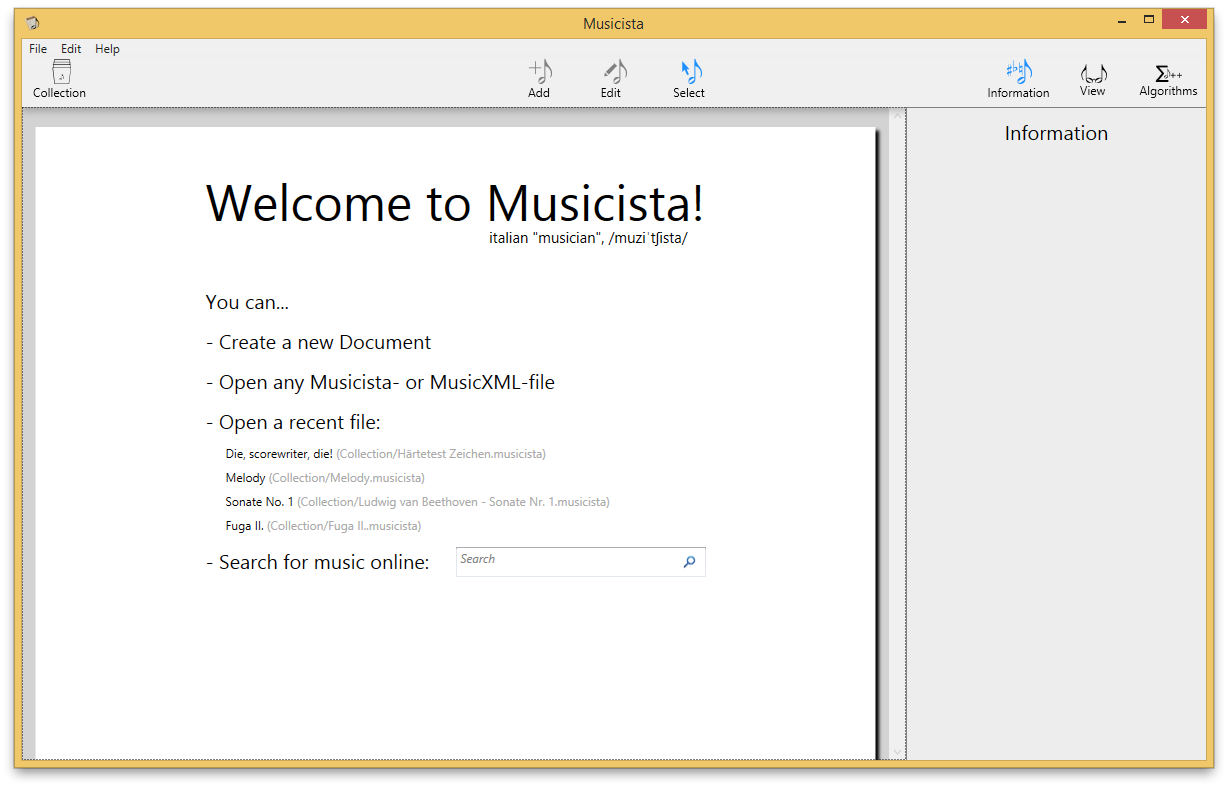
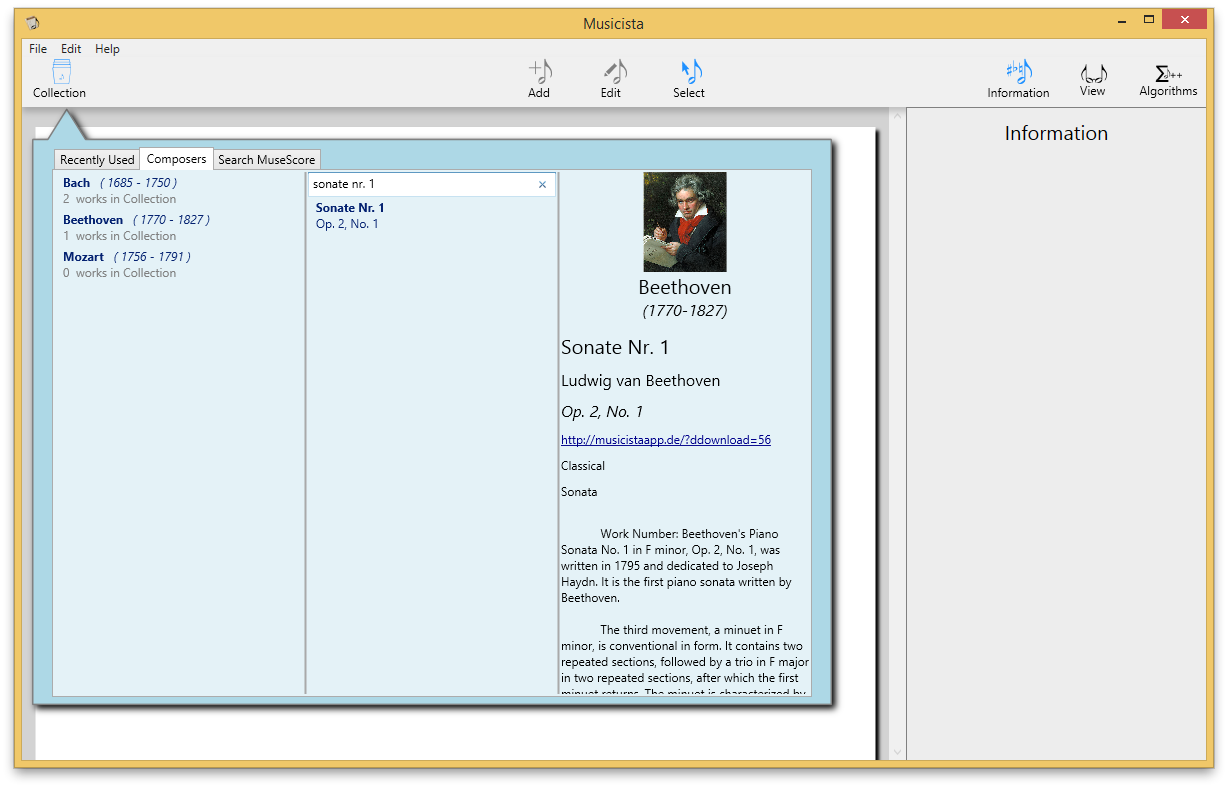
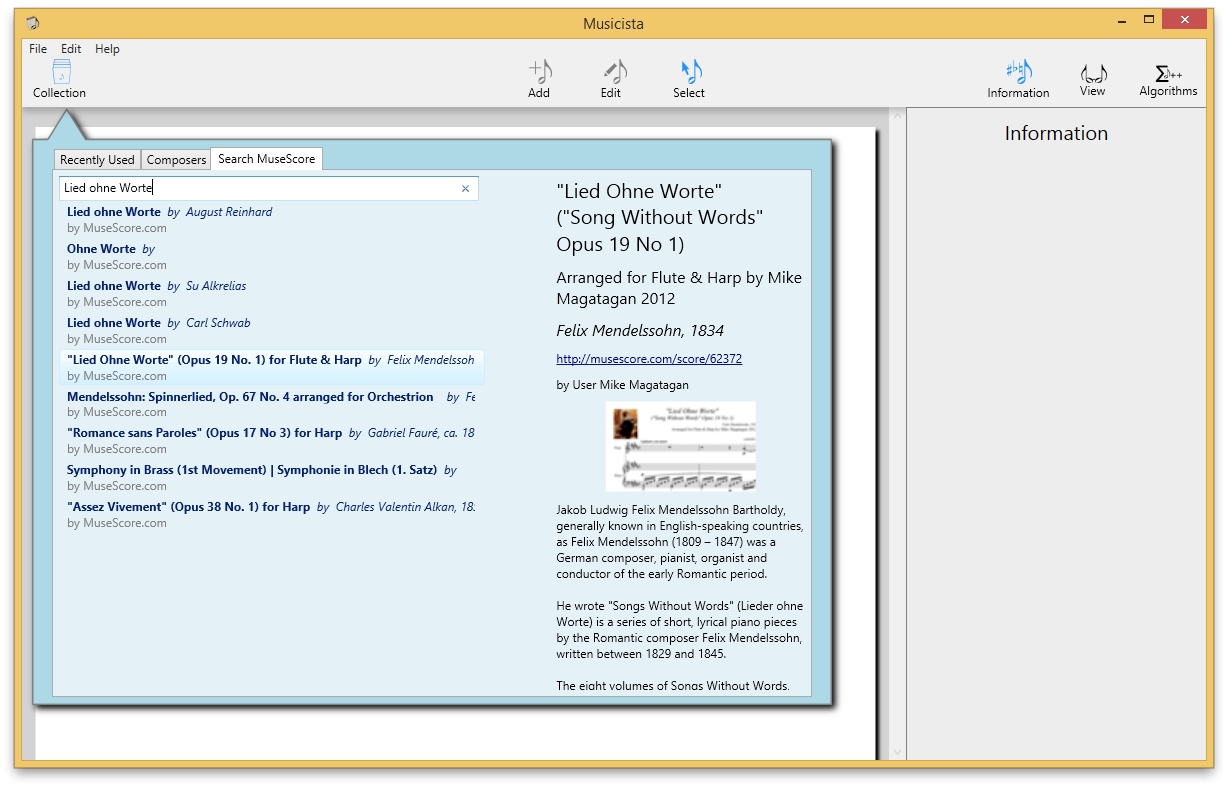
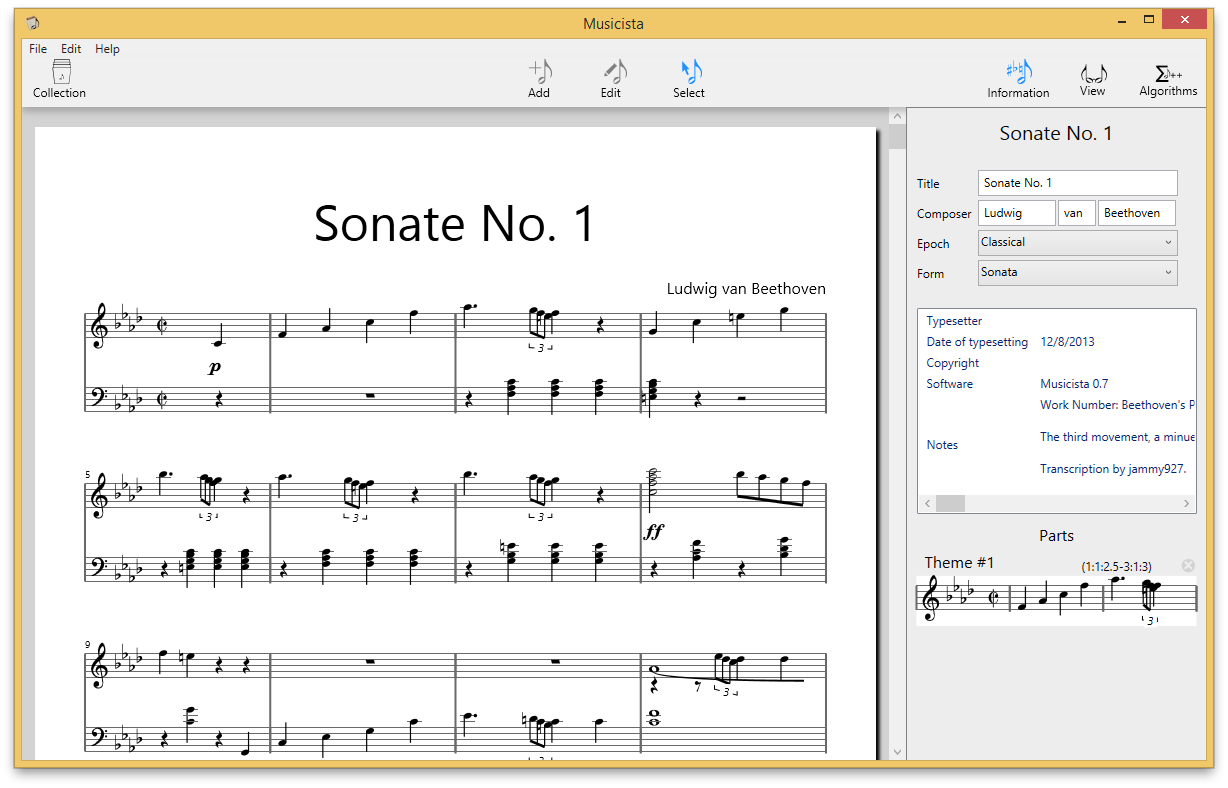
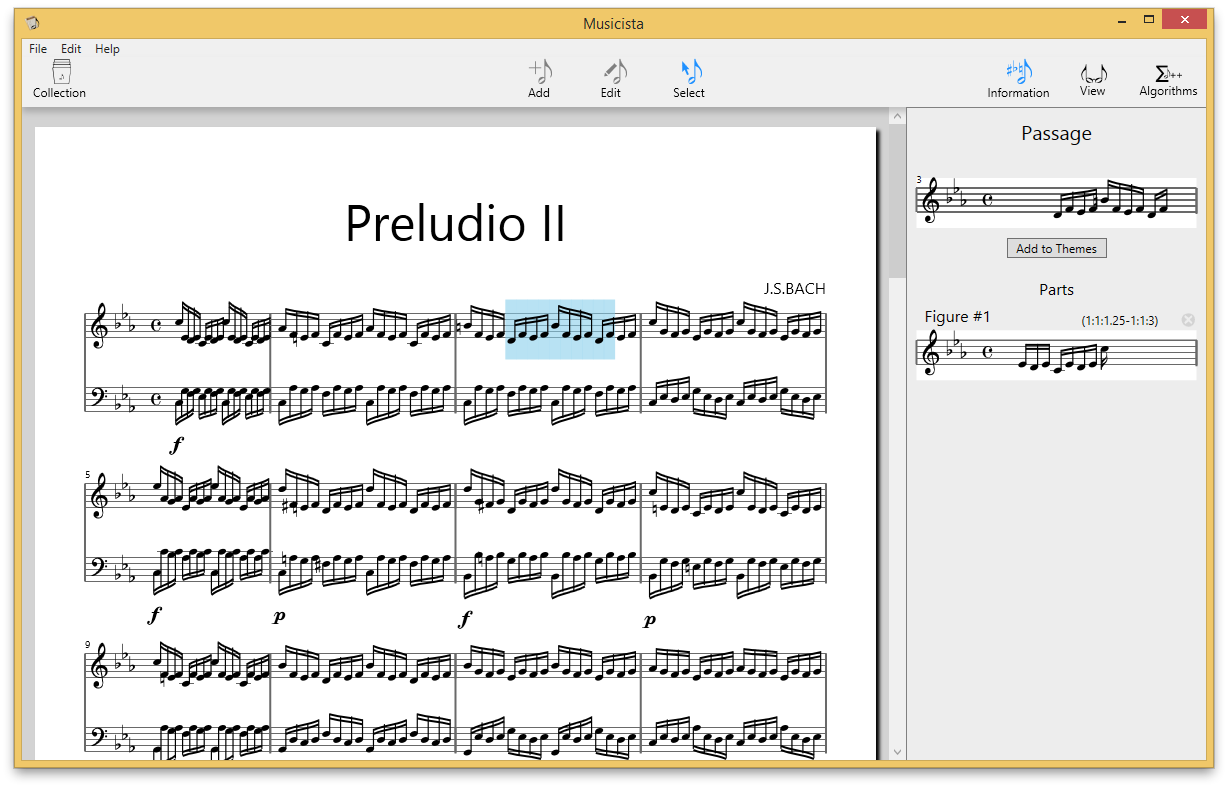
TinyNotation is easy and intuitive:
Thanks to the guys at music21 who inspired this dialect!
All articulation keywords: